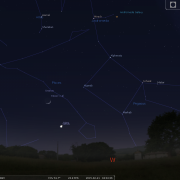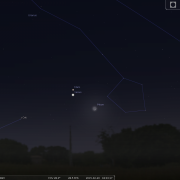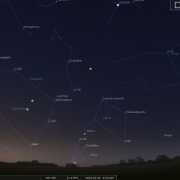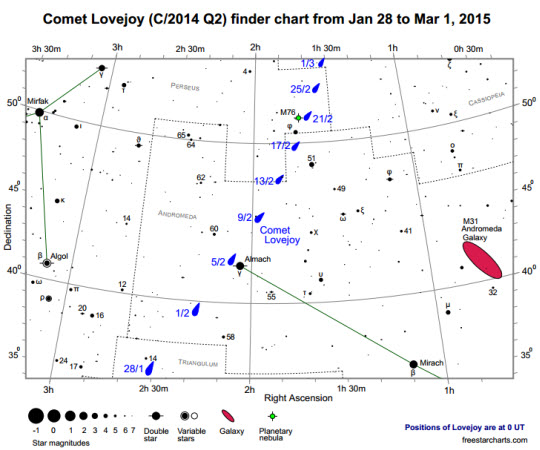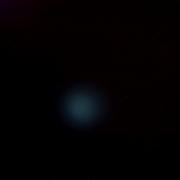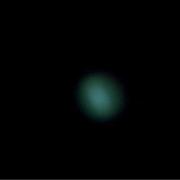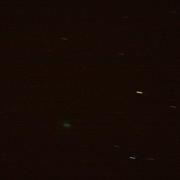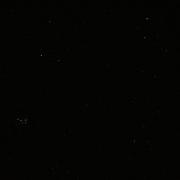In this month's Sky Notes:
Planetary Skylights
Let us first have a look in the evening twilight sky where brilliant Venus (you cannot mistake it low down above the SW horizon) has close encounters with both Neptune and Mars during February.

 The one with Neptune (left) occurs on the 1st and will be best chance to spot the outer gas world before it is lost in glare. With Venus (right) at Magnitude -3.8 and Neptune at +8, the brightness difference is rather large, to say the least. Neptune will appear as a tiny blue-grey fuzz point through binoculars ¾ of a degree upper right of Venus. View around 5:45pm in the SW.
The one with Neptune (left) occurs on the 1st and will be best chance to spot the outer gas world before it is lost in glare. With Venus (right) at Magnitude -3.8 and Neptune at +8, the brightness difference is rather large, to say the least. Neptune will appear as a tiny blue-grey fuzz point through binoculars ¾ of a degree upper right of Venus. View around 5:45pm in the SW.
 Then on the 21st Venus and Mars are separated by less than a degree with Mars to the upper right again. Mars will be at mag +1.2, readily visible to the naked eye. View around 6:30pm. A slim crescent moon joins the party on the 20th and 21st.
Then on the 21st Venus and Mars are separated by less than a degree with Mars to the upper right again. Mars will be at mag +1.2, readily visible to the naked eye. View around 6:30pm. A slim crescent moon joins the party on the 20th and 21st.
While  Venus may be conspicuous for the early part of the evening Jupiter (left), rules the night sky, coming to opposition on Feb. 6th and dominating the eastern aspect before 11pm. By midnight Jupiter will lie due south, ahead of the sickle asterism in Leo and therefore not far from its chief star, Regulus, although from the 4th Jupiter actually lies in Cancer. Jupiter offers up a wealth of detail when viewed through a scope, the dance of the galilean moons from day to day being particularly fascinating to follow. The moon lies nearby on the 3rd.
Venus may be conspicuous for the early part of the evening Jupiter (left), rules the night sky, coming to opposition on Feb. 6th and dominating the eastern aspect before 11pm. By midnight Jupiter will lie due south, ahead of the sickle asterism in Leo and therefore not far from its chief star, Regulus, although from the 4th Jupiter actually lies in Cancer. Jupiter offers up a wealth of detail when viewed through a scope, the dance of the galilean moons from day to day being particularly fascinating to follow. The moon lies nearby on the 3rd.
 Saturn is visible in the dawn sky. Look for it after 5am when it lies low to the ESE a hand span above the horizon. The moon lies nearby on the 13th.
Saturn is visible in the dawn sky. Look for it after 5am when it lies low to the ESE a hand span above the horizon. The moon lies nearby on the 13th.
Meteor Activity

The minor Alpha Aurigids meteor shower peaks from Feb 6 - 9th. Rates are barely on a par with sporadic levels (4-6), but if you do happen to spot a shooting star heading away from the direction of the zenith, (overhead) where Auriga resides at this time of year, it is likely to be an Aurigid!
Comet Lovejoy 2014
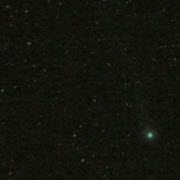
Impressive photo of Comet
C/2014Q2 Lovejoy by Les,
who Mark met while working in
the Magpie Café. Taken with a
camera on a motorised mount.
(Click image for full view)
The weather hasn’t been kind over the ‘dark window’ period in which comet Lovejoy has been readily visible. It’s not that it has been totally cloudy, just cloudy at the wrong times, Spells of strong gusty winds and then mist and frost have all contributed to making observations a little tricky and very frustrating.
The comet reached 4th magnitude and is still below 5th magnitude as it continues to track across the sky heading to the right of Perseus and into Andromeda. Despite the difficulties with the British weather, Keith and Mark have managed to capture some images of the comet. Keith managed to capture the comet's coma through the Cooke refractor at the Bruce Observatory. Several timed images were attempted with the scope tracking the comet. Although little detail is revealed the results clearly show the comets greenish head.
Mark took some timed exposures just on a tripod, (the comet is just about visible as a green dash). Unfortunately moonlight is going to interfere for the first 9 days in February and further imaging will be hampered. Throughout the middle part of January the comet was easily seen in binoculars, appearing as a grey- green blob. It should still be apparent during the February, so please do try to spot it if not already done so.
Mark further reports that on the 24th of Jan under clear, dark skies a definite tail could be made out through binoculars.
Here are some Members' photos of the comet:
February 2015 Sky Charts
Click each image to see a full-size Sky Chart:
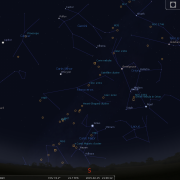 |
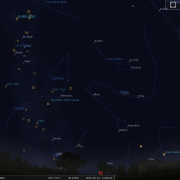 |
| Looking South Mid February - 21:15h |
Looking North |
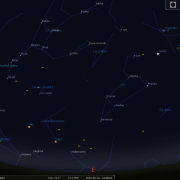 |
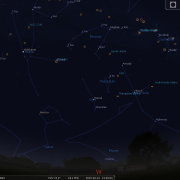 |
| Looking East Mid February - 21:15h |
Looking West Mid February - 21:15h |
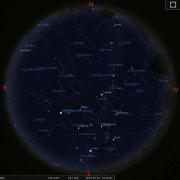 |
|
| Overview Mid-February - 21:15h |
Image Credits:
- Planets and Comets where not otherwise mentioned: NASA
- Sky Charts: Stellarium Software
- Log in to post comments


